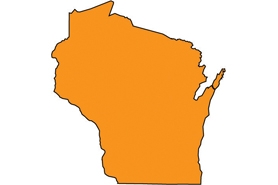Musk thistle
(Carduus nutans)
Herbaceous biennial. Plants overwinter as rosettes in the first year and bloom in the second year. Flowering plants are one to seven feet tall. Musk thistle has a multi-branched stem that appears winged.
Other names for this plant include:
- Common names: nodding thistle
- Scientific names: C. macrocephalus; C. nutans spp. macrocephalus; C. nutans ssp. leiophyllus
Classification in Wisconsin: Restricted
- Ecological Threat
-
- It Invades pastures, old fields, roadsides, waste areas, ditch banks and prairies.
- In meadows and pastures, grazing animals avoid musk thistle and focus on native plants giving the invasive the upper hand.
- Identification
-
First-year plants-leaves: Basal leaves are up to 12-17” long, lance- to oblong-shaped and lobed with spiny margins.
Second-year plants-leaves: Alternate leaves clasp the stem giving it a winged appearance. They are coarsely lobed with prominent terminal spine and slightly wavy, smooth, and hairless on both sides. Leaves are dark green with light green midribs and a white margin.
Flowers: Musk thistle has large red to purple, solitary, terminal flowerheads, 1.5-3” across, and usually bent over or “nodding.” Blooms May through August.
Fruits & seeds: A single flowerhead can produce up to 1,200 seeds that are viable for over ten years. Wind-dispersed seeds can travel long distances.
Roots: Single taproot.
Similar species: Native marsh thistle (Cirsium muticum) has non-spiny stems and flower heads. Canada thistle (Cirsium arvense; invasive) has no winged stem or spines on its stem or flower heads. Bull thistle (Cirsium vulgare; non-native) has prickly winged stems; leaves have itchy hair above and wooly white hair below. The single or clustered purple flowers, 1.5-2” across, are borne at the branches' ends and enclosed by narrow, spine-tipped bracts.
- Control
-
Mechanical: Sever root one to two inches below the soil surface. Repeated mowing (minimum two to three times per growing season) when flower buds are about to open will prevent seed production.
Chemical: Applications are most effective when plants are in the rosette stage. Foliar spray with glyphosate during the bolting phase when plants are 6-10” tall, during the bud-to-flower phase, or rosettes in the fall. It can also apply a foliar spray with clopyralid or metasulfuron-methyl. For musk thistle on severely disturbed sites, use 2, 4-D ester or dicamba in the early bolting phase. Or apply in combination – dicamba with 2, 4-D ester.
Biological: The flower head weevil (Rhinocyllus conicus) and the rosette weevil (Trichosirocalus horridus) have been released in some states but not in Wisconsin due to risks presented to rare native thistles.
- Resources
- Sources for content:
- Czarapata, Elizabeth; Invasive Plants of the Upper Midwest: an illustrated guide to their identification and control. The University of Wisconsin Press. 2005. Pg. 101-102
- Gassmann A. and L.T. Kok. Musk thistle In Van Driesche, R., et al., 2002, Biological Control of Invasive Plants in the Eastern United States, USDA Forest Service Publication FHTET-2002-04, 413 p [exit DNR]. Last updated Nov. 5, 2003.


